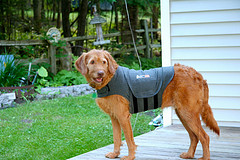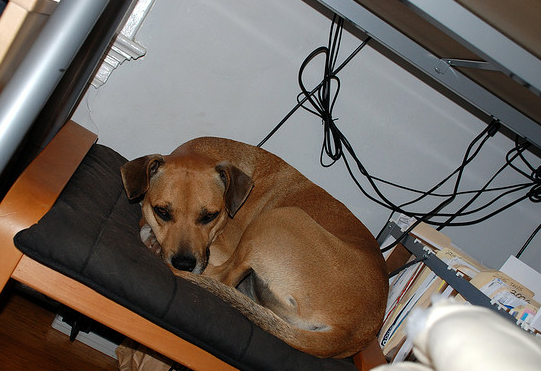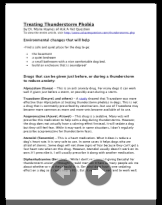Treating Thunderstorm Phobia in Dogs
Many dogs are afraid of thunderstorms. While some dogs are simply afraid of the loud noises, many people believe that dogs with thunderstorm phobias are sensing the atmospheric pressure changes as well.
You will read of many different remedies for thunderstorms. I wrote this article to give an unbiased view of these different remedies. Hopefully this information will help if your dog is afraid of thunder!
Contents of this article:
Environmental changes that will help.
Drugs used to Treat Thunderstorm Phobia
Natural Treatments
Thundershirts
Desensitization program (including thunderstorm tracks)
Environmental changes that will help
Many dogs will do really well in a thunderstorm if they are given a safe and quiet place to go to. I had one client who solved her dog’s thunderstorm anxiety by building a soundproof plexiglass enclosure in one of her closets. She taught the dog that he could go into this enclosure during a storm and he would not hear the thunder.
Other safe places for dogs to go include:
- the basement
- a quiet bedroom
- a small bathroom with a nice comfortable dog bed.
Drugs used to treat thunderstorm phobias
There are a number of drugs that veterinarians will prescribe for fear of thunderstorms. Some drugs will work better for some dogs than others.
Drugs that can be given just before, or during a thunderstorm to reduce anxiety:
Alprazolam (Xanax) - This is an anti anxiety drug. For many dogs it can work well if given just before a storm, or possibly even during a storm.
Trazodone (Desyrel, and others) - A study showed that Trazodone was more effective than Alprazolam at treating thunderstorm phobias in dogs. This is not a drug that is commonly prescribed by veterinarians, but use of Trazodone may become more common as more and more vets become available of its use.
Acepromazine (Acevet, Atravet) - This drug is a sedative. Many vets will prescribe this medication to help calm a dog during thunderstorms. However, the drug does not actually have a calming effect! Instead, it will sedate a dog but they still feel fear. While it may work in some situations, I don’t regularly prescribe acepromazine for thunderstorm fears.
Atenolol (Tenormin) - This is a heart medication. What it does is reduce a dog’s heart rate. It is very safe to use. In some cases it helps dogs who are afraid of storms. Some dogs will not show signs of fear because they can’t get a fast heart rate when on this drug. However, Atenolol usually doesn’t work on its own. If I prescribe it, I will usually prescribe it along with another medication.
Diphenhydramine (Benadryl) - While I don't recommend giving Benadryl for thunderstorm anxiety, I thought I would mention it here as many people ask me about whether or not they should try it. Benadryl does have some sedating effect on a dog so it could help a little. But, it really does not tend to work well.
Long term medications that can be given throughout the thunderstorm season:
Clomipramine (Clomicalm) - This is a drug that I will commonly prescribe for dogs who have problems with anxiety. It can often work quite well to help with thunderstorm phobias. However, it is not a drug that you can use sporadically. If I prescribe this medication for storm fear, I usually recommend starting it in the spring time. Then, near the end of the fall we can wean the dog off of the medication.
Fluoxetine (Prozac, Reconcile) - This is another anti-anxiety medication that often works well in dogs. Similar to Clomicalm, it would be started at the beginning of thunderstorm season and can be tapered off during the winter months. Recently, a drug company named Elanco has come out with Reconcile which is a canine formulation of the human drug Prozac. This means that more vets will likely be prescribing this drug for anxiety problems.
Natural treatments for Thunderstorm Fear
DAP - Dog Appeasing Pheromone - Most veterinary behavior specialists speak highly of DAP. This product is similar to Feliway for cats. It releases something called a pheromone which naturally signals the dog to be calm. You can buy it as a plugin diffuser or as a collar that your dog wears. For more information, and to find out where to buy DAP online, check out my article on Dog Appeasing Pheromone.
This product can really help reduce thunderstorm anxiety (but often it will need to be used along with other medications or treatments).
Melatonin - Until recently I had never heard of using Melatonin to help with thunderstorm anxiety. There are many homeopathic vets who are recommending it. Last year, I had a question asked on AskAVetQuestion.com about using melatonin for fear of fireworks (which is very similar to thunderstorm anxiety) : Can I use Melatonin for Fear of Fireworks?
Here is an excerpt:
Well unfortunately, Buster did not respond well to the closet seclusion. He suffered all day Saturday due to firecrackers and other noise-makers. He was very anxious, shaking and unable to relax at all. So, we did give him 1mg of Melatonin at about 8:30 pm on Saturday. As a result, Buster learned what it truly felt like to relax on vacation! It was really amazing! Within half an hour of taking the med, he became very calm while still awake, and within the hour he even ate his food that he'd been ignoring for 2 days. He remained calm, yet alert, for the rest of the night. He lounged around indoors; he never resumed his usual shaking and never once sought to be picked up or tried to get out of the house or yard - all of which he had been doing almost non-stop during the noise previously. During the fireworks' finale, he picked up his head and looked around for a minute, but that was it. It was like a little miracle! There were no noticable side effects, and the next morning he was very well-rested and extra frisky. It was really very nice. It changed our whole weekend. We gave him another mg on Sunday eve when the noise began and again Monday night with the same results. He was a bit anxious when outside near the noise, but indoors it was as if nothing was happening even though the noise was easily heard indoors and had previously greatly upset him. I will use it again for the next fireworks and for any expected prolonged thunderstorms. Thanks for your help.
If you are going to try Melatonin, the dose is 1mg for a small dog or 3 mg for a large dog. You need to be sure to get Melatonin that is meant to be swallowed and not the type that dissolves under your tongue...unless you have a very talented dog and you can teach him to hold a pill under his tongue. :)
Rescue Remedy - This is a homeopathic product that contains a number of flowers that are meant to help reduce anxiety in dogs. There is a lot of testimonial evidence, but not much scientific evidence for its use. There is absolutely no harm in using it. You can buy it online here. However, I have found that for most dogs with thunderstorm anxiety, this product really doesn’t work that well.
Peppermint oil. Some homeopathic veterinarians will recommend putting one drop of peppermint oil on the bottom of each of the dog’s feet to help with thunderstorm phobia. I have actually heard a number of vets claim that this works well for anxious dogs. But, I have yet to have one of my clients try it. If you use this remedy, I’d love for you to leave a comment for me and let me know how it worked for you!
Does a Thundershirt work?

When I first heard of Thundershirts I was skeptical. To me, it looked like a company that was trying to take advantage of owners who were desperate for help with their fearful pets. However, a number of veterinarians are finding that their pets with fear of storms are being greatly helped by these shirts.
The idea is that applying pressure to several areas on the dog’s body has a calming effect on the dog. I did some searching and found some research articles that were interesting:
Comparison of the effectiveness of a purported anti-static cape (the Storm Defender®) vs. a placebo cape in the treatment of canine thunderstorm phobia as assessed by owners’ reportsUse of a Cape in the treatment of canine thunderstorm phobia
I also found an article written by Dr. Janet Tobiassen Crosby of about.com. You can read the article here.
Dr. Tobiassen Crosby talked about trying the thundershirt on her own dog. Here are her words about the product:
Then it was time for bed, fireworks still going on (ugh). I left the Thundershirt on Sophie. She fell asleep, which meant I could, too.
The real test was at 5am. We awoke to a continual bam-bam-bam. More fireworks. I wasn't sure at first though, because there was Sophie, sound asleep. This is not typical for her. In a situation like this, she would be nudging me awake, whining and pacing. She was slumbering away. Whew.
This is an encouraging test of the Thundershirt that I was unable to do last year, and I would recommend this product to those pets who suffer from loud noise phobias and other anxiety-based problems, either alone (mild cases) or in conjunction with other therapies.
It looks like products like the Thundershirt may actually be helpful for many dogs with thunderstorm anxiety. I would love to hear from any of you who have used one!
I have found that one of the best places to buy a Thundershirt online is on Amazon. Clicking on the dog below will take you to an Amazon search for Thundershirts.

Thunderstorm Desensitization Program:

Photo by hillary h, flickr.
Drugs alone are not the best way to treat a dog with thunderstorm anxiety. If you have the patience and time to do this, I would highly recommend a desensitization program to go along with the above therapies. The idea is that you play simulated thunderstorm sounds at a very low volume and teach the dog to enjoy this. (I’ll explain how later on). Then, you gradually increase the volume of the recording until the dog can be listening to very loud thunderstorms and not be anxious.
Of course though, playing thunderstorm sounds does not completely simulate a storm as there is no change in atmospheric pressure. But, if you take the steps outlined below, it really should help.
It is best to do this over a period of a week or two. Ideally it would be best to do this training when there are no thunderstorms in the forcast. If a loud thunderstorm happens in the middle of this training period it may set us back a little. It is a good idea to ask your vet for a prescription of either Trazadone or Alprazolam to use on the days when there is a thunderstorm.
1. Designate a “safe” place for your dog.
This could be a bedroom, a bathroom, the basement or even the downstairs. Our first goal is to teach the dog that this place is AWESOME. Don’t even think of playing the thunderstorm sounds until we have established that this place is great. It may take a few days to do this.
2. Think of a name for your dog’s safe place.
You can call it whatever you want, but for now, I’ll call it - “your room”. So, grab a handful of treats and say to your dog, “Hey! Let’s go to your room!” Then, walk into the room and give the dog a few treats.
Do this several times a day for a few days. Get really excited about it! Out of the blue just say, “HEY! Let’s go to YOUR ROOM!”, and then go with your dog to the safe place and give him treats.
3. Teach your dog to be calm in the safe place.
After you have done this for two to three days, the next step is to teach your dog to be calm and relaxed in his safe place. So, say to him, “Let’s go to your room!” Go to the safe place but don’t give him any treats. Instead tell him to lie down and then, once he has done that give him treats.
Do this several times a day. However, each time you do it, wait a little bit longer before he gets his treats. The idea is to teach him that he needs to go to his safe place, lie down and be quiet and then he’ll get a treat.
Work up to him lying in his safe place for 5 minutes before he gets his treat. Once you have this accomplished then move on to step 4. Again, this may take a few days, so be patient! It’s really important not to rush things!
4. Introducing some thunderstorm noise.
In this step, we are going to start playing some thunderstorm noises. You can buy CDs online that play thunderstorm sounds, but I’ve found some online that you can use for free. Ideally it is best to have these sounds playing out of a good quality stereo (as opposed to your computer speakers.)
(Thank you to the Free Sound Project for supplying these tracks!)
Thunderstorm - by martin lightningOhio Storm - by Corsica_S
Thunderstorm - by inchadney
Thunderstorm in Berlin - by faruku
Choose one of the above sounds. The first one is a good one to start with. It’s good to mix up which sound you play on a given day so that your dog doesn’t get accustomed to just one track. Have your dog in the room with you and start playing the thunderstorm track on REALLY low volume. Ideally it’s best if you can start the track by using a remote so that your dog doesn’t know that you are doing it, but this isn’t mandatory.
Watch for signs that your dog is taking note of the sound - ears go up, starts to tremble, looks anxious. The moment you see anything like that then say “Let’s go to YOUR ROOM!” and go to the safe place, tell him to lie down and give him treats.
If your dog is super anxious then wait a day before you try this again and try it with the recording at an even lower level.
Later on in the day, repeat this process using the same volume level. We want to make it so that the dog gets excited when he hears thunder because he knows he gets to go to his room and get treats!
5. Increasing the intensity
Once you feel that your dog is enjoying going to his room when the recording is on, then it’s time to try the recording at a slightly higher volume. Over the next few days, several times a day we’re going to repeat this process. It is really important that we don’t go too fast! If you think your dog is getting anxious then take it down a notch and try again the next day.
Eventually we should get to the point where we can have the recording blaring at full volume and the dog is happily sitting in his safe place eating treats. Once we get to this point, if you want to you can start to lessen the number of treats and the frequency at which he gets them.
Important: If your dog is anxious during this process and reducing the volume is not working, then you should highly consider speaking to your veterinarian about using an anti-anxiety medication during the thunderstorm season.
Also: If you are using a lot of treats during this time period, you may want to decrease the amount of food your dog is getting so that he doesn’t gain weight!
Note! This page is for information only and not meant to diagnose or treat your pet. If you have concerns about your pet's issues with thunderstorm anxiety the best thing you can do is to call your veterinarian!
Leave a comment below!
(Dr. Marie does not answer questions via the comments section, though!)
Dr. Marie was quick to respond and thorough in suggesting treatment for my cat. I am so thankful- I have been so worried about my cat. Now I have additional options to discuss with my vet.
The service was incredibly fast and the vet's suggestions were right on target. This was incredibly helpful given that none of the vets in my area, mine now included, will take off hours calls now.
 Dr. Marie is a veterinarian who practices in a busy animal hospital in Ottawa, Ontario. She created Ask A Vet Question as a resource for good, accurate veterinary advice online. Dr. Marie treats dogs, cats, hamsters, guinea pigs, and rats. She has been a vet since 1999.
Dr. Marie is a veterinarian who practices in a busy animal hospital in Ottawa, Ontario. She created Ask A Vet Question as a resource for good, accurate veterinary advice online. Dr. Marie treats dogs, cats, hamsters, guinea pigs, and rats. She has been a vet since 1999.
Is an online vet visit just as good as a trip to your veterinarian? No! But, many times, asking an online veterinarian a question can help save you money. While Dr. Marie can't officially diagnose your pet or prescribe medications, she can often advise you on whether a vet visit is necessary. You can also ask Dr. Marie for a second opinion on your pet's condition.















